As you embark on your journey to understand the Aroon Indicator, you'll find that mastering its basics is crucial for making informed trading decisions.
Delving into the top 10 essentials of this indicator can provide you with a solid foundation to navigate the complexities of the market confidently.
From unraveling the key takeaways to formulating effective trading strategies, each aspect plays a vital role in enhancing your analytical skills and honing your trading acumen.
Stay tuned to discover how these fundamental aspects of the Aroon Indicator can propel your trading endeavors to new heights.
What Is the Aroon Indicator?
What exactly does the Aroon Indicator measure and how is it structured?
The Aroon Indicator is a tool used in trading to measure the time elapsed between highs and lows within a specific period. It consists of two lines: Aroon Up and Aroon Down.
The Aroon Up line is calculated based on the number of periods since the last high, while the Aroon Down line is based on the periods since the last low. This indicator helps traders identify bullish and bearish behaviors in the market.
Values nearing 100 on the Aroon Indicator signal strong trends, while values close to zero indicate weak trends. Additionally, crossovers between the Aroon Up and Aroon Down lines can indicate potential changes in market trends.
Key Takeaways on Aroon Indicator
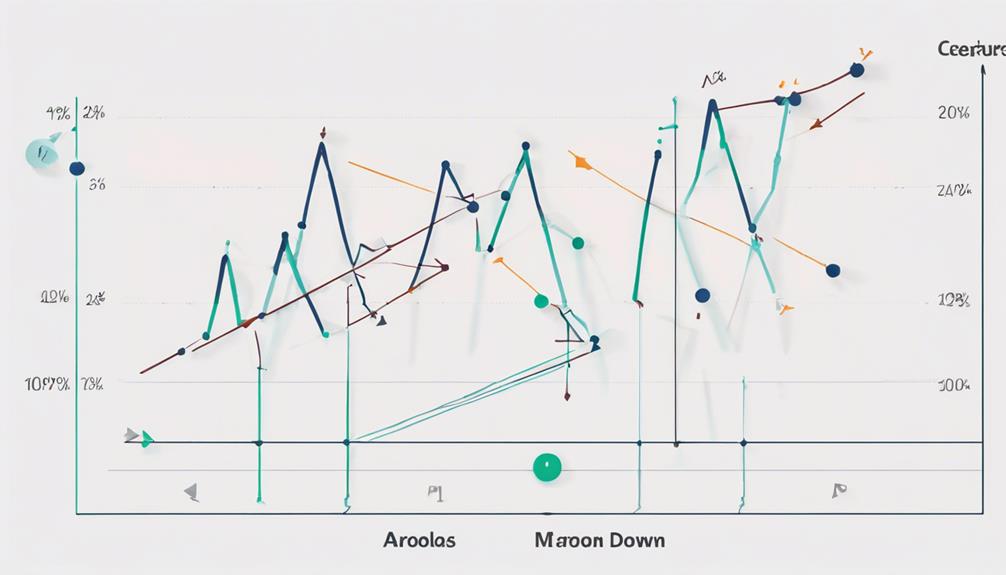
Delve into the essential insights provided by the Aroon Indicator to grasp its significance in market analysis and trading strategies. The Aroon indicator shows the trend and bullish behavior in the market through the following key takeaways:
- Aroon Indicator consists of Aroon Up and Aroon Down lines that indicate bullish or bearish behavior.
- Aroon lines fluctuate between 0 and 100, with values near 100 signaling strong trends.
- Crossovers between Aroon Up and Aroon Down lines mark trend changes, offering potential entry or exit points.
- It helps traders identify trend changes, analyze bullish behavior, and recognize consolidation periods in asset prices.
Formulas for Aroon Indicator
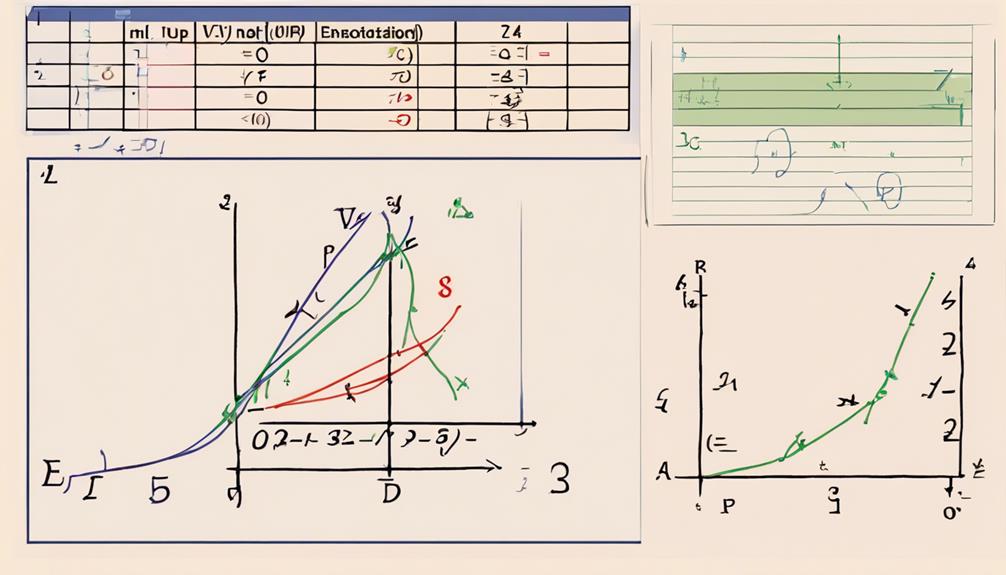
When calculating the Aroon Indicator, understanding the formulas for Aroon Up and Aroon Down is crucial. These formulas show the strength and direction of a trend based on the number of periods since the highest high and lowest low.
Interpreting Aroon values can provide valuable insights into potential trend changes and market momentum.
Calculation of Aroon
To calculate the Aroon indicator, you can use the following formulas for Aroon Up and Aroon Down, which involve tracking the number of periods since the highest high and lowest low within a specified period:
- Aroon Up calculation: [(Number of periods) – (Number of periods since the High)] / (Number of periods) * 100%
- Aroon Down calculation: [(Number of periods) – (Number of periods since the Low)] / (Number of periods) * 100%
- Aroon Indicator tracks 25 periods of highs and lows for calculations.
- Aroon lines fluctuate between 0 and 100 based on recent price highs and lows.
These formulas are essential for understanding the Aroon indicator's insights into trend strength and direction, providing valuable information for traders and analysts.
Interpreting Aroon Values
Understanding the Aroon values in the Aroon Indicator involves interpreting the calculated percentages of Aroon Up and Aroon Down to gauge trend strength and potential market movements. Aroon values range from 0 to 100, with higher values indicating stronger trends.
The Aroon Up and Aroon Down formulas track days since the last high and low to determine trend strength. When Aroon Up is above Aroon Down, it suggests bullish momentum, indicating a potential entry point. Conversely, if Aroon Down is dominant, it signals a bearish trend, offering a potential exit point.
Calculating Aroon Indicator
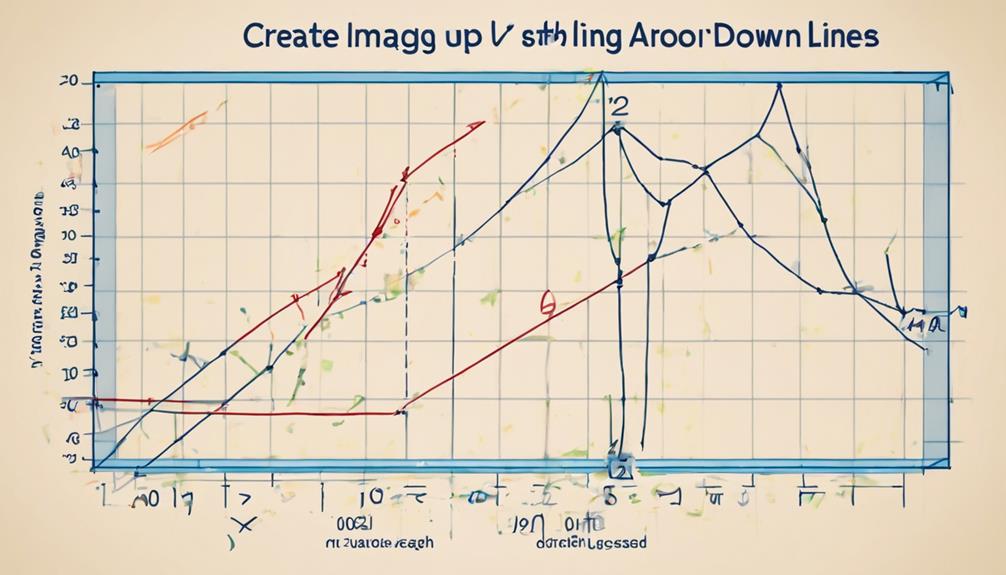
To calculate the Aroon Indicator, you need to understand the Aroon-Up and Aroon-Down components.
Aroon-Up is determined by the number of periods since the highest high, while Aroon-Down looks at the number of periods since the lowest low.
These calculations provide insight into the strength and direction of a trend.
Aroon up Calculation
When calculating the Aroon Indicator, the Aroon Up is determined by subtracting the number of periods since the High from the total number of periods, then dividing by the total number of periods and multiplying by 100%.
Aroon Up measures the time since the highest price within a specified period.
Values range from 0 to 100, indicating the strength of the uptrend.
Aroon Up crossing above 50% signals a potential uptrend initiation.
A higher Aroon Up value suggests a stronger trend in the asset's price movement.
Aroon Down Calculation
For a comprehensive understanding of the Aroon Indicator, it's essential to delve into the calculation of Aroon Down, a key component in assessing market trends.
Aroon Down is calculated by determining the number of periods since the lowest low within a specified timeframe. The formula for Aroon Down is [(Number of periods) – (Number of periods since the Low)] / (Number of periods) * 100%. This metric measures the strength of a downtrend by indicating how close the current low is to the lowest low.
Aroon Down values nearing 100 suggest a robust downtrend, while values closer to zero indicate a weakening downtrend. By working in conjunction with Aroon Up, Aroon Down helps traders identify trend strength and potential trend reversals in the market.
Interpreting Aroon Indicator Signals
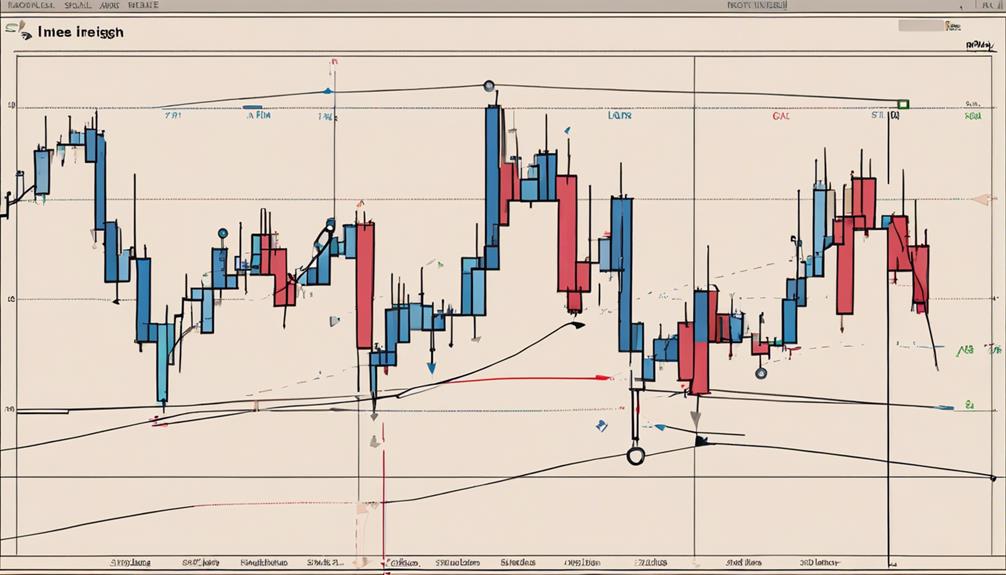
One crucial aspect in deciphering Aroon Indicator signals involves analyzing the crossovers between Aroon Up and Aroon Down. When interpreting the Aroon Indicator signals, keep in mind the following key points:
- Aroon Up crossing above Aroon Down signals a potential uptrend initiation.
- Aroon Down crossing above Aroon Up suggests a possible downtrend starting.
- Aroon Up above 50% with Aroon Down below 50% confirms a bullish trend.
- Aroon Down above 50% while Aroon Up is below 50% confirms a bearish trend.
Understanding these signals can provide valuable insights into potential bullish price movements and help you make informed decisions based on the Aroon Indicator.
Practical Application of Aroon Indicator
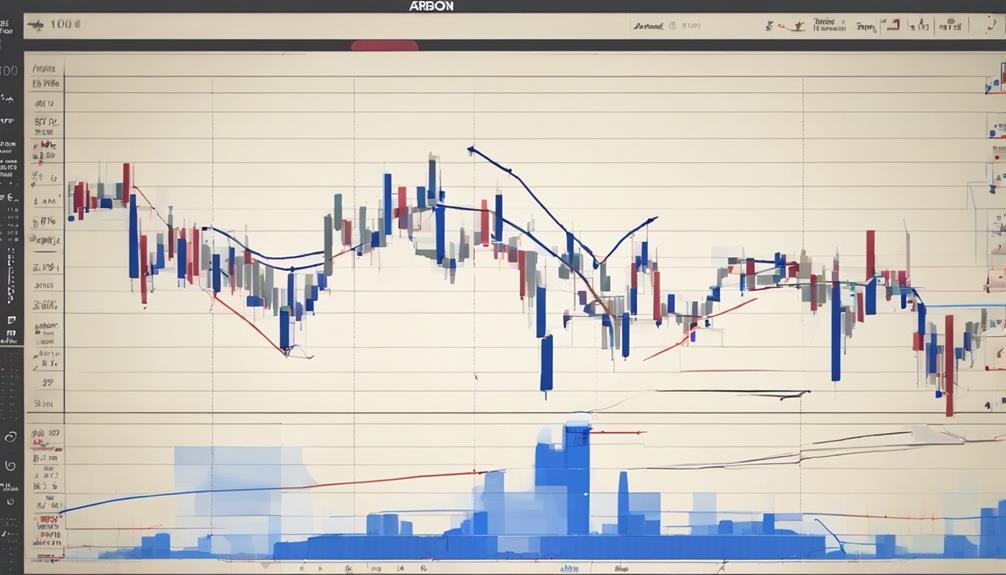
When applying the Aroon Indicator, consider strategy examples, timing trades effectively, and setting trade alerts to maximize its potential benefits.
These points can assist you in making informed decisions based on the indicator's signals, helping you navigate the market more efficiently.
Strategy Examples
Utilizing the Aroon Indicator in real-world scenarios can provide traders with valuable insights into market trends and potential trading opportunities. When applying the indicator to your trading strategies, consider the following:
- Identification of Bullish Behavior: Look for instances where the Aroon Up line is above the Aroon Down line, signaling a bullish trend.
- Spotting Trend Changes: Pay attention to crossovers between the Aroon Up and Aroon Down lines as they may indicate potential trend reversals.
- Confirmation with Other Indicators: Combine the Aroon Indicator with other technical tools to enhance your trading strategy and validate signals.
- Exploring Market Dynamics: Analyze the relationship between Aroon Up and Aroon Down lines for deeper insights into market movements and trade opportunities.
Timing Trades
To effectively time your trades using the Aroon Indicator, focus on identifying key trend shifts signaled by the crossovers between the Aroon Up and Aroon Down lines. When the Aroon Up line crosses above the Aroon Down line, it suggests a potential uptrend, while the opposite indicates a probable downtrend. These crossovers can serve as entry signals for your trades, aligning with market trends identified by the Aroon Indicator.
Setting Trade Alerts
Setting trade alerts with the Aroon Indicator involves monitoring crossovers between the Aroon Up and Aroon Down lines to detect potential trend changes. When setting alerts, consider the following:
- Traders can set alerts for Aroon Up crosses above Aroon Down to indicate potential bullish movements.
- Alerts can be configured for Aroon Down crossing above Aroon Up, signaling possible bearish trends.
- Setting alerts at specific Aroon levels (e.g., above 50 for uptrends, below 50 for downtrends) aids in capturing trend changes.
- Utilizing trade alerts based on Aroon Indicator signals enhances timely decision-making and trade execution.
Aroon Indicator Vs. DMI
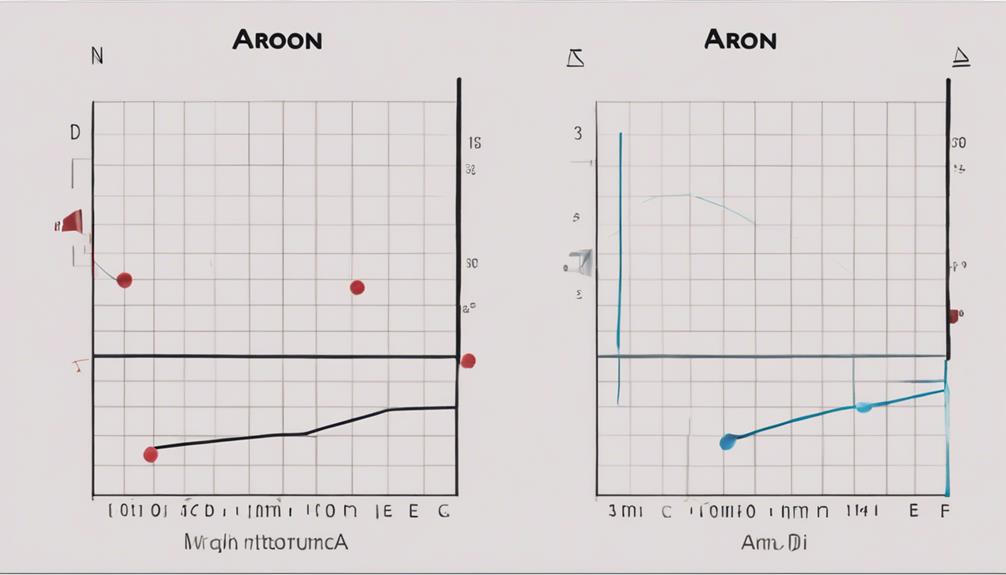
Comparing the Aroon Indicator with the DMI reveals distinct approaches to assessing trend strength in the financial markets. The Aroon Indicator focuses on time between highs and lows, emphasizing time analysis to measure trend strength.
In contrast, the DMI, or Directional Movement Index, concentrates on price differences to evaluate trend strength based on price movements. While the Aroon Indicator is effective for analyzing time-based trends, the DMI is more useful for assessing price-based trends.
Understanding these differences is crucial for enhancing technical analysis and developing successful trading strategies. By utilizing the strengths of both indicators, traders can gain a comprehensive view of trend dynamics in the market, leading to more informed decision-making processes.
Aroon Indicator Trading Strategies
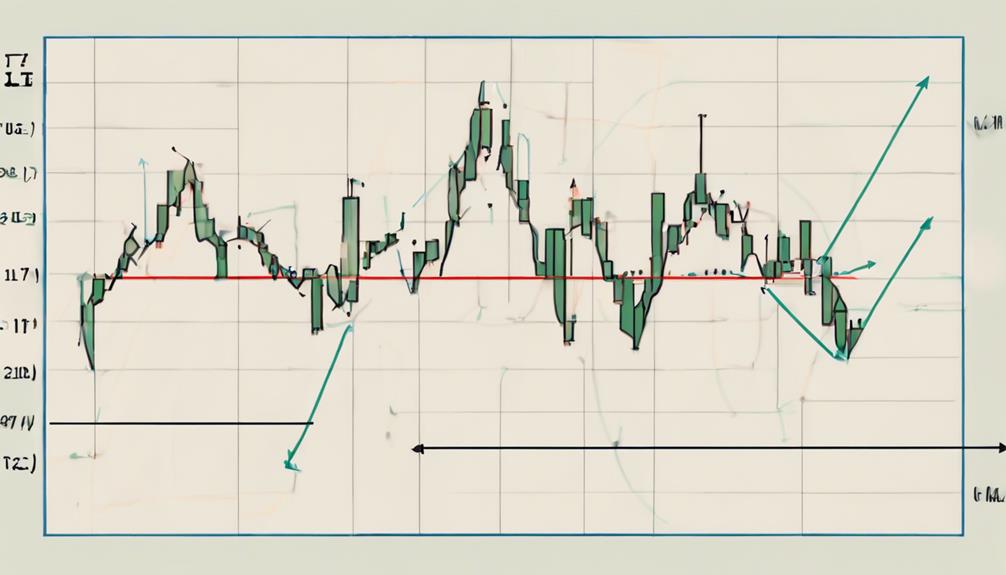
Utilize breakout trading strategies with the Aroon Indicator by focusing on Aroon Up crossing above Aroon Down for potential market entry signals. When incorporating the Aroon Indicator into your trading strategies, consider the following:
- Look for Aroon Up crossing above Aroon Down to identify potential entry points.
- Analyze Aroon Indicator readings above 50 for indications of strong trends.
- Utilize Aroon Indicator crossovers for entry and exit signals in binary options trading strategies.
- Compare the Aroon Indicator to ADX to assess trend strength and make informed trading decisions.
Aroon Indicator Limitations

The Aroon Indicator's effectiveness can be hindered by several limitations that traders should be aware of when incorporating this tool into their analysis. It may provide late signals in choppy markets, leading to missed trading opportunities. Additionally, false signals can occur, where crossovers between Aroon lines don't always result in significant price moves as expected.
Since the indicator looks backward at historical data, it isn't predictive of future price movements. To mitigate these limitations, traders are advised to use additional analysis alongside the Aroon Indicator for better decision-making. Relying solely on the Aroon Indicator for trading decisions isn't recommended due to its potential shortcomings.
Aroon Indicator Tips for Beginners
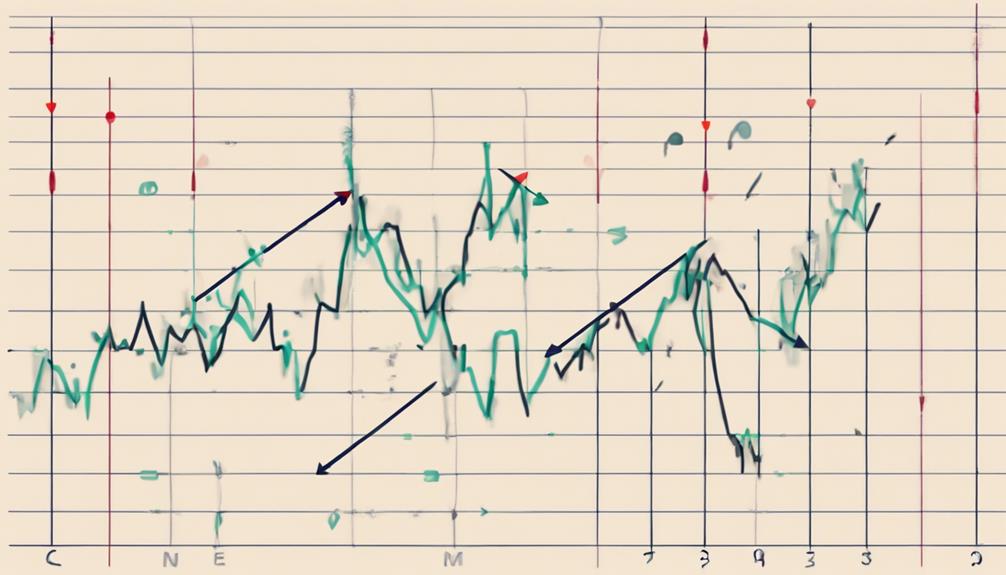
To maximize the effectiveness of the Aroon Indicator as a beginner, consider implementing the following practical tips for better utilization and understanding of this trend strength measurement tool.
- Regularly Monitor Indicator Lines: Keep a close eye on both the Aroon Up and Aroon Down lines to gauge trend strength accurately.
- Combine with Other Indicators: Utilize the Aroon Indicator in conjunction with other technical analysis tools to validate entry or exit points.
- Adjust Period Settings: Experiment with different period settings to align the Aroon Indicator with your trading strategy and time frame.
- Practice with Historical Data: Backtest the Aroon Indicator on historical data to gain confidence in interpreting its signals for real-time trading decisions.
How Can Beginners Use the Aroon Indicator Effectively?
For newbies looking to use the Aroon indicator effectively, it’s important to follow some essential Aroon indicator steps for newbies. First, familiarize yourself with the indicator’s values and understand how it indicates trend strength and direction. Then, practice using it on historical data to identify trends and make informed trading decisions.
Frequently Asked Questions
What Is the Best Strategy for Aroon?
To excel with Aroon, focus on crossovers of Aroon Up and Aroon Down. Boost accuracy by confirming signals with other indicators. Gauge trend strength and reversals. Combine Aroon with Moving Averages or RSI for thorough analysis. Entry/exit points hinge on trend strength and market conditions.
How Do You Read an Aroon Indicator?
When reading an Aroon Indicator, focus on Aroon Up crossing above Aroon Down for potential uptrends and vice versa for downtrends. Values near 100 signal strong trends; values close to 0 indicate weak trends.
What Is the Best Indicator for Beginners?
For beginners, the Aroon Indicator stands out as a top choice. It offers clear entry and exit signals, aiding in trend identification. Combining it with other indicators can provide a comprehensive analysis, making it a valuable tool.
How Accurate Is the Aroon Indicator?
In trading, the Aroon Indicator's accuracy depends on market conditions and timeframe. Combining it with other indicators can enhance precision. Aroon performs better in trending markets. Consider it with price action analysis for improved results.
Conclusion
In conclusion, mastering the basics of the Aroon Indicator is essential for beginners looking to navigate the complexities of the market.
By understanding the formulas, calculations, and interpretations of Aroon signals, traders can effectively identify trends and potential reversals.
Remember to consider the limitations of the indicator and develop sound strategies to maximize its utility.
With practice and dedication, you can leverage the Aroon Indicator to make informed trading decisions and achieve success in the market.
